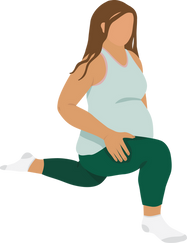Spinning Babies Timeline: When and How to Start for Easier Birth
- Cheyenne Williamson
- Jul 22
- 3 min read
If you’ve heard of Spinning Babies, you’ve probably heard it’s great for helping baby get into a better position for birth. But when exactly should you start?
As a doula and birth educator who’s spent a lot of time researching movement, fetal positioning, and comfort techniques, I can tell you this: it’s never too early to begin—but how and what you do does depend on where you are in pregnancy.
First Trimester: Awareness + Gentle Foundations
This is a time to focus on body balance and general well-being. It’s not about complex techniques—it’s about preparing the body for the months ahead. Gentle stretches, posture awareness, and good alignment are a great place to start.
What to Try:
Focus on good posture when sitting and standing (avoid reclining too often)
Gentle prenatal yoga or stretching focused on hip mobility
Daily brisk walks with aligned posture
Begin exploring pelvic tilts and diaphragmatic breathing

Second Trimester: Build the Routine
Now’s the perfect time to start incorporating more intentional movement. This is when you might start exploring the Spinning Babies® Daily Essentials, Side-Lying Release, or learning how your body and baby work together in space.
This is also a great time to start exploring labor positions that promote optimal fetal positioning—something I’ve made incredibly accessible in A Doula’s Guide to Labor Positions. Understanding how movement supports progress early on builds confidence and reduces fear later.
What to Try:
Spinning Babies® Daily Essentials routine (start with 3–4x/week)
Side-Lying Release with a trained partner or provider
Prenatal yoga with an emphasis on pelvic alignment and flexibility
Hip circles, forward-leaning inversions, and balance work
Incorporating asymmetrical movements like lunges and stair climbing
Third Trimester: Intentional Prep
This is when many people first hear about Spinning Babies®—but it’s actually most helpful when built on earlier work. Now’s the time to be consistent with Daily Essentials and add positional awareness into your day. In my book, I highlight upright, asymmetrical, and forward-leaning positions that are especially helpful here, including:
Standing Lunge
Birth Ball Rock + Tilt
Open Knee Chest
These positions help the baby engage and rotate more easily through the pelvis. Practicing them daily can promote comfort and encourage optimal positioning before labor begins.
What to Try:
Spinning Babies® Daily Essentials (start with 3–4x/week):
Forward-Leaning Inversions
Pelvic Tilts
Rebozo Sifting
Standing Sacral Release
Postural awareness and rest-smart positioning
Upright and forward-leaning positions from A Doula’s Guide to Labor Positions
Hands-and-knees movements like rocking, cat/cow, and supported squats
Asymmetrical movements such as lunges and exaggerated side-lying
Chiropractic care or bodywork focused on pelvic balance (if available)
Labor: Don’t Stop Moving
Even with an epidural, gentle movement, position changes, and Spinning Babies®-informed strategies can still support progress. That’s why A Doula’s Guide to Labor Positions includes options for every type of birth—home, hospital, medicated, or not.
What to Try:
Repositioning every 30–45 minutes
Side-lying with a peanut ball
Upright positions with support (standing, kneeling, hands-and-knees)
Asymmetrical positions like lunge or exaggerated side-lying
Restorative positions between contractions to conserve energy
Partner-supported positions such as:
Supported squat with partner behind
Standing hip squeezes
Rebozo sifting with partner assistance
Double hip squeeze or counterpressure techniques
Understanding when and how to use Spinning Babies techniques can help make pregnancy more comfortable and birth more efficient. Start early, move often, and if you need support knowing which positions can help most, I made a whole guide just for that: A Doula’s Guide to Labor Positions.




























Comments